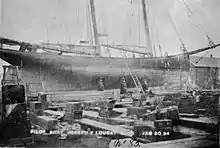Joseph F. Loubat
The Joseph F. Loubat was a 19th-century New York Sandy Hook pilot boat. She was the largest of the pilot-boats in the Sandy Hook service[1] and was assigned the "Number 16" as displayed on her mainsail. She was one of the last pilot-boats that were sold in an age of steam and electricity.[2]
 The New York Pilot Boat Joseph F. Loubat No. 16. | |
| History | |
|---|---|
| Name: | Joseph F. Loubat |
| Namesake: | Joseph Florimond Loubat, yachtsman and author |
| Owner: | N. Y. Pilots: Electus Comfort, W. J. Barry, James McCarthy, and Maurice J. Mariga |
| Builder: | Jacob S. Ellis's shipyard in Tottenville, Staten Island |
| Cost: | $13,000 |
| Launched: | 18 December 1880 |
| Out of service: | 1 February 1896 |
| Fate: | Sold |
| General characteristics | |
| Class and type: | schooner |
| Tonnage: | 150 Thames Measurement |
| Length: | 88 ft 0 in (26.82 m) |
| Beam: | 21 ft 0 in (6.40 m) |
| Draft: | 10 ft 0 in (3.05 m) |
| Depth: | 9 ft 0 in (2.74 m) |
| Propulsion: | Sail |
| Sail plan: | 75 ft 6 in (23.01 m) |
| Notes: | Her cabins and state rooms were finished with hardwood |
Construction and service
On Saturday, December 18, 1880, the Joseph F. Loubat was launched from the Jacob S. Ellis's shipyard in Tottenville, Staten Island. A large number of pilots and their families came to the shipyard to observe the launch of the new pilot-boat.[1]
She was built by Jacob S. Ellis at an expense of $13,000, for co-ownership with Electus Comfort, W. J. Barry, James McCarthy, and Maurice J. Mariga. Her length was 88 feet, breadth of beam 21 feet, depth of hold is 9 feet and 150 tones. The name of the boat was chosen for Joseph Florimond Loubat, who was a yachtsman and author of one of the earliest American yachting memoir: A Yachtsman’s Scrap Book, or the Ups and Downs of Yacht Racing. Captain Electus Comfort was master of the boat.[1] The Joseph F. Loubat was registered with the Record of American and Foreign Shipping from 1882-1888.[3]
Boat accidents

On April 27, 1888, the Ward Line steamer Santiago, hit the Loubat, pilot-boat when she was at anchor at the Sandy Hook bar. Captain, Frank P. Van Pelt and other pilots were rescued from the boat.[4][5]
Another accident occurred on January 1, 1894, when the Loubat, went ashore two miles east of the Amagansett Life Saving Station. The crew on the pilot-boat were saved by the men from the lifesaving station. The four pilots on board were C. J. Madigan, Thomas Shields, William Ferro, and Frank P. Van Pelt.[6]
Out of service
On February 1, 1896, the New York Pilots discarded the Loubat, along with fifteen other sailboats and moved them to the Erie Basin in Brooklyn. They were replaced with new up-to-date steam pilot-boats. The Joseph F. Loubat, was sold cheap for $4,000. Other pilot boats that were sold were the William H. Starbuck, Richard K. Fox, and the Edmund Blunt.[2]
References
- Loubat, Joseph Florimond (1887). A yachtsman's scrap book: or, The ups and downs of yacht racing. New York: Brentano Brothers. p. 268.
- "Not Up To Date. Why New York Pilots Are Discarding Sailboats. They Must Catch Steamers". The Standard Union. Brooklyn, New York. 1896-02-01. p. 7. Retrieved 2020-09-08.
- "Index to Ship Registers: Record of American and Foreign Shipping 1882". Mystic Seaport Museum. New York. Retrieved 2020-08-18.
- Allen, Edward L. (1922). Pilot Lore From sail to Steam. New York: The United New York and New Jersey Sandy Hook Pilots Benevolent Associations.
- "Good By Pilot Boat No. 16. The Joseph F. Loubat Sank at Ancher by the Steamship Santiago". The Sun. New York, New York. 27 Apr 1888. p. 1. Retrieved 2020-09-12.
- "Pilot Boat Ashore. The Joseph F. Loubat, No. 16, Aground Near Amagansett". The Evening World. New York, New York. 16 Jan 1894. p. 1. Retrieved 2020-09-12.